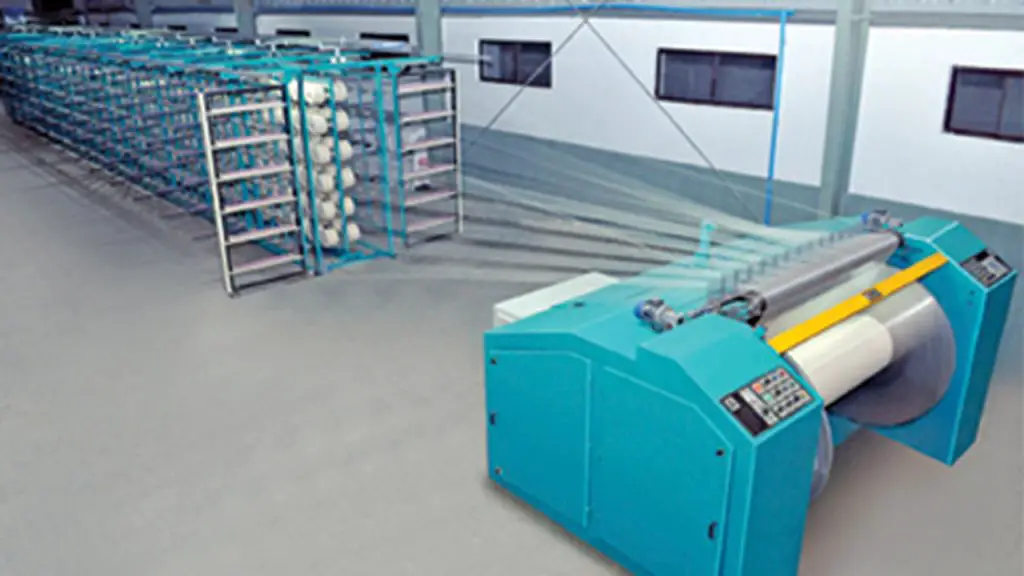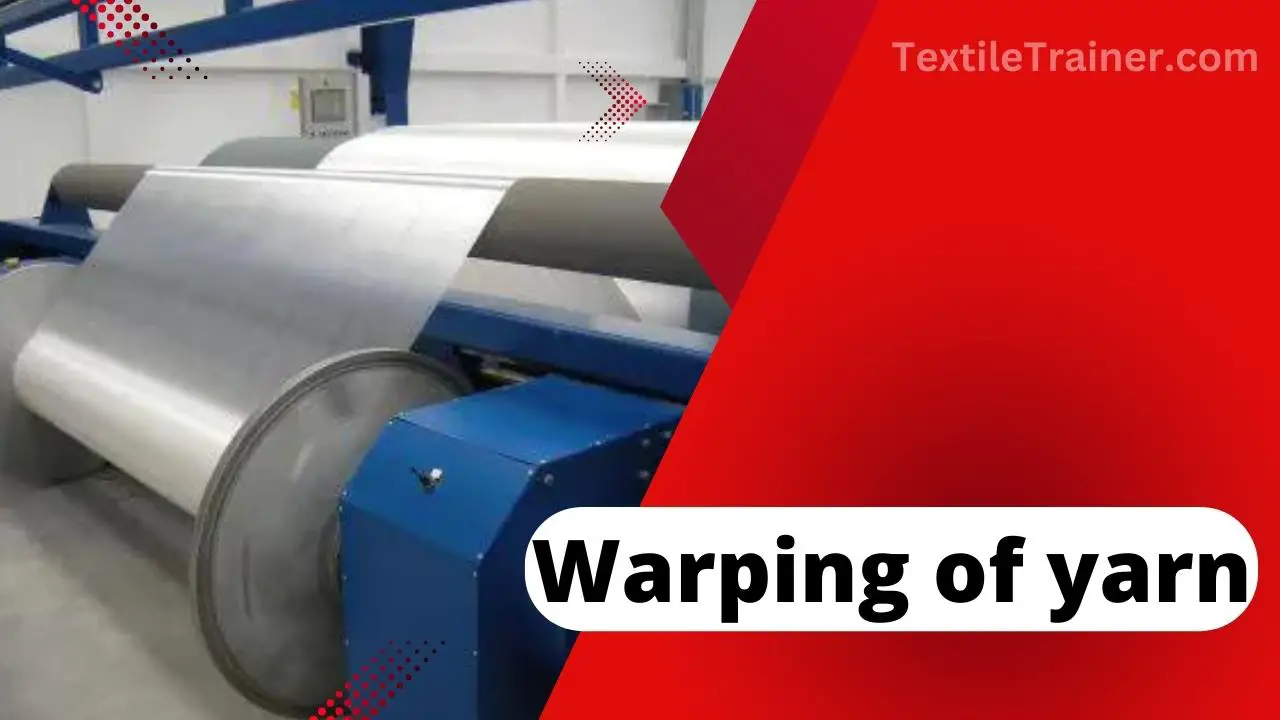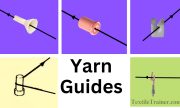What is Warping?
The warping of yarn in weaving is the process by which the yarns are arranged and prepared to form the longitudinal structure of fabric in a systematic and orderly manner. A warp yarn is a lengthwise thread held under tension during weaving.
During the warping process, the desired length of yarn is measured and wound onto a warping beam or a warp beam. In weaving, warp beams wind yarns parallel, side-by-side, to form cylindrical packages. The warp beam serves as the primary yarn source for the weaving process. When warping, yarn tension and alignment are carefully maintained. This prevents tangling, breakage, or uneven yarn distribution during weaving. A protective coating or sizing agent is often applied to them to enhance the strength of the warp yarns and prevent abrasion during weaving. It also improves the overall performance of warp yarns and the final woven fabric. Once the warping process is completed, the warp beam is mounted onto the loom, and the warp yarns are threaded through the heddles and the reed. Each warp yarn is threaded through a heddle, which controls its vertical movement, and then through a reed, which maintains the spacing between warp threads. A high-quality woven fabric requires proper warping. It ensures an even distribution of yarn tension, consistent interlacing with the weft yarns, and the desired characteristics of the finished product, such as strength, stability, and pattern accuracy.

Objects/Importance of Warping of Yarn:
- Preparation of Warp Yarn: The primary objective of warping is to prepare the warp yarns for weaving by winding them onto a warp beam in an orderly and controlled manner.
- Even Distribution of Yarn: Warping helps maintain consistent tension and spacing while winding warp yarns side by side in parallel layers. Warping prevents tangles and irregularities during weaving.
- Alignment and Parallelism: Warping ensures that the warp yarns are aligned parallel to one another. Proper parallelism enables warp and weft yarns to interlace during weaving, resulting in a uniform fabric width and straight selvages.
- Tension Control: A key objective of warping is to ensure that the warp threads are neither too loose nor too tight during weaving, resulting in a well-balanced fabric.
- Sizing Application: Warping processes include the Application of sizing to warp yarns. A sizing agent improves yarns’ strength, abrasion resistance, and weaving performance by applying a protective coating or sizing agent. An essential objective of sizing is to increase the strength and durability of woven fabrics.
- Efficiency and Productivity: By arranging the warp yarns correctly onto the warp beam, warping improves the efficiency and productivity of the weaving process, reducing downtime and improving productivity.
The primary purpose of warping in weaving is to ensure proper tension and alignment, achieve even distribution, and increase the quality and efficiency of weaving fabrics.
Important Requirements of Warping:
It is essential that the warping meets the following requirements:
- In order to prevent breakage and to prevent damage to the ready cloth, all wound ends must be uniformly tensioned during withdrawal from supply packages.
- The tension should be moderate to maintain the yarn’s elastic properties and strength to prevent it from losing its physical and mechanical characteristics. Sharp abrasives should not be used on the yarn.
- There must be uniform yarn spreading across the warping package’s whole width since the warping package’s surface must be cylindrical.
- It is recommended that a predetermined length of warping is observed.
- Warping should be produced at the highest rate possible in order to achieve the best results.
- It is extremely important to guarantee that the warp yarns are properly tensioned throughout the warping process to avoid yarn breakage, tangling, or sagging, resulting in a smooth and trouble-free weaving process.
- The warp yarns must be aligned parallel to each other during the warping process for the fabric to have a uniform width and a straight selvage. Any deviation from parallel alignment can cause irregularities or distortions in the fabric due to warping.
- When handling warp yarns during the warping process, the yarns should be handled with care to prevent damage, tangling, or contamination. Proper handling practices, such as gently winding, avoiding excessive tension, and maintaining cleanliness, will help preserve the quality of the warp yarns.
Types of Warping:
There are three types of warping processes. They are as follows:
- High speed warping or beam or direct warping.
- sectional warping or pattern warping.
- Ball warping.
1. High speed warping:
The process of warping the yarns taken directly from the single packages on the creel and laying them directly on the beam is called direct warping. It is also called high speed or beam warping. In this method, cotton warps can be produced primarily when starch is required for the yarn to be woven as part of the sizing process, after which the yarn is sent to the loom to be woven. This cotton warp production method is mainly used when the yarn needs to be prepared with starch. In addition, as mentioned above, the method can also be used to produce beams from continuous filament yarns.
2. Sectional warping:
This is a process of weaving towels with stripes that involves the winding of the yarn on the beam in sections starting with the tapered end of the beam. Sectional warping is used for weaving towels with stripes. Including many yarn colors in a weaver’s beam is possible using sectional warping. In order to prevent the yarns from falling off of the drum, there is an angle on the drum of the beam. Sectional warping is essential when making a yarn-dyed towel with stripes.
3. Ball warping:
The process of ball warping involves weaving multiple ends of yarn on a wooden ball using rope form. It consists in collecting the ends in an untwisted rope for dyeing. It consists of creeling yarn’s ends (between 350 and 500 ends). The rope is wound on a log cylinder on a machine called a ball warper.
Finally we can say, Warping is a fundamental process in weaving that involves the preparation and arrangement of yarn onto a warp beam or similar device. It plays a crucial role in ensuring the smooth and efficient operation of the weaving process. By properly winding the yarn onto the warp beam, weavers can achieve even tension, accurate alignment, and consistent spacing of the warp threads, which are essential for producing high-quality woven fabrics.
In this article, I have tried my best to provide a clear understanding of how yarn is warped. Please support me by sharing my article with your friends on social media.







I really appreciate this post. I¡¦ve been looking all over for this! Thank goodness I found it on Bing. You’ve made my day! Thank you again
stay with us. thanks too.
Very neat post.Really looking forward to read more. Keep writing.
keep visit our site….
Wow, great blog article.Thanks Again. Much obliged.
keep visit our site….
wow, awesome blog article.Thanks Again. Great.
please share our article…
Hey, thanks for the article.Really thank you! Really Great.
thanks too….please support us….
Very informative blog post.Really thank you! Keep writing.
thanks too
Hello There. I found your blog using msn. This is a very wellwritten article. I’ll make sure to bookmark it and come back to read more ofyour useful info. Thanks for the post. I’ll definitely return.
Thank you dear. Stay with us. Happy reading.
Very informative post.Really looking forward to read more.
keep visit our site…thank too….
Im obliged for the post.Really thank you! Fantastic.
please support us.
You ought to take part in a contest for one of the greatest blogs on the net. I will recommend this blog!
thanks for recommended.
I really enjoy the blog article.Much thanks again. Really Cool.
I just like the valuable information you provide for your articles.I’ll bookmark your blog and test again right here regularly.I am relatively certain I will be informed many new stuff right right here!Best of luck for the following!
You could certainly see your enthusiasm in the work you write. The world hopes for even more passionate writers such as you who are not afraid to mention how they believe. At all times follow your heart.
Lovely postings. Thank you.how to write an essay proposal narrative essay writing help business writing services
Thanks
Pretty much all features in this release are absolutely amazing
Thanks. Always stay with us.
Hey! This post could not be written any better! Reading through this post reminds me of my good old room mate! He always kept talking about this. I will forward this article to him. Fairly certain he will have a good read. Thank you for sharing!
This unique blog is obviously educating and also amusing. I have picked up many helpful tips out of this blog. I ad love to visit it over and over again. Thanks!
You can certainly see your enthusiasm in the work you write. The arena hopes for even more passionate writers such as you who aren’t afraid to say how they believe. All the time follow your heart.
I like reading through a post that can make men and women think. Also, thanks for allowing for me to comment!
A big thank you for your article post.Really thank you! Keep writing.
Thank you for your post.
Major thanks for the article.Really looking forward to read more. Really Great.
Great, thanks for sharing this article post.Much thanks again. Really Cool.
wow, awesome post.Really looking forward to read more. Much obliged.
Your style is very unique in comparison to other people I’ve read stuff from. I appreciate you for posting when you’ve got the opportunity, Guess I’ll just bookmark this blog.
thanks for bookmark….
I truly appreciate this post. Will read on…
I really liked your blog article.Really thank you! Really Cool.
A round of applause for your blog.Thanks Again. Much obliged.
Wow, great article post.Much thanks again. Really Cool.
Thanks again for the post. Cool.
thanks too….please support us……
Hey, thanks for the article post.Much thanks again. Cool.
I truly appreciate this blog article.Really thank you! Awesome.
Thank you ever so for you article. Awesome.
Hey! This is my first comment here so Ijust wanted tto give a quic shoutout and say I truly enjoy reading through your articles.Appreciate it!
keep visit our site..
When someone writes an article he/she maintains the idea of a user in his/her mind that how a user can know it. Thus that’s why this article is outstdanding. Thanks!
Really informative blog.Really looking forward to read more. Keep writing.
I really enjoy the article.Much thanks again. Really Cool.
I value the blog post.Really looking forward to read more. Fantastic.
Really informative blog article.Really looking forward to read more. Will read on…
Hey, thanks for the blog article.Thanks Again. Will read on…
Great write ups. Thanks.how to be a good writer essay developing a thesis statement article ghostwriter
I really enjoy the article.Thanks Again. Cool.
I really like and appreciate your blog post.Thanks Again. Really Great.
Major thanks for the article.Really thank you! Will read on…
Hey, thanks for the blog post.Much thanks again. Really Great.
I truly appreciate this article.Really looking forward to read more. Will read on…
Very informative post.Really looking forward to read more. Awesome.
Really informative blog post.Really thank you! Want more.
A round of applause for your article. Keep writing.
Really informative article.Much thanks again. Cool.
Say, you got a nice blog.Really thank you! Great.
Really informative blog.Really thank you! Want more.
I loved your post.Really thank you! Much obliged.
Awesome blog.Thanks Again.
Major thanks for the post.Thanks Again. Will read on…
Thank you ever so for you blog post.Really thank you! Awesome.
Fantastic article post.Thanks Again.
Wow, great blog.Much thanks again. Much obliged.
Thanks so much for the blog. Cool.
I loved your blog post.Really looking forward to read more. Want more.
Very informative article post.Really looking forward to read more. Want more.
A big thank you for your article.Really thank you!
Very informative blog post.Much thanks again. Keep writing.
Very informative blog.Really thank you! Want more.
Thanks for the article post.Thanks Again. Fantastic.
I am so grateful for your blog.Much thanks again. Really Cool.
Thanks for the article.Thanks Again. Much obliged.
Major thankies for the post.Really thank you!
Very neat post.
Very good blog article.Really thank you! Cool.
I value the blog.Really thank you! Want more.
Thanks so much for the blog.Really thank you! Great.
Thanks a lot for the blog post.Really thank you!
Say, you got a nice post.Really looking forward to read more. Keep writing.
Keep on working, great job!
A round of applause for your blog article.Much thanks again. Keep writing.
I cannot thank you enough for the blog.Thanks Again. Great.
Muchos Gracias for your article post.Much thanks again. Want more.
Thanks again for the blog article.Much thanks again. Want more.
I really enjoy the blog post.
Looking forward to reading more. Great blog.Much thanks again. Great.
Major thankies for the post.Really thank you! Really Great.
Really appreciate you sharing this blog. Keep writing.
Thank you for your post. Much obliged.
wow, awesome article.Thanks Again. Fantastic.
Enjoyed every bit of your article post.Much thanks again. Want more.
A big thank you for your article post. Much obliged.
Great post.Really thank you! Keep writing.
Very good article.
Im grateful for the post.Much thanks again. Much obliged.
Appreciate you sharing, great article post.Really thank you! Will read on…
Im grateful for the article. Will read on…
Fantastic blog.Much thanks again. Really Great.
Fantastic article.Really looking forward to read more. Cool.
Very neat blog post.Really looking forward to read more. Will read on…
I think this is a real great post.Really looking forward to read more. Cool.
A big thank you for your post.Really thank you! Awesome.
Really enjoyed this blog article.Really thank you! Fantastic.
I really like and appreciate your blog.Really thank you! Will read on…
I appreciate you sharing this post.Really thank you! Really Great.
Really enjoyed this blog article. Really Great.
Wow, fantastic weblog layout! How lengthy
have you been blogging for? you make blogging look easy. The full glance of your web site is great,
as well as the content material!
Thank you so much.
Thank you ever so for you blog. Really Great.
I value the blog post.Much thanks again. Great.
Great, thanks for sharing this blog article.Much thanks again. Really Great.
Thank you ever so for you blog post. Fantastic.
I really liked your blog post.Thanks Again. Want more.
I am so grateful for your post.Really thank you! Want more.
Thank you for your blog.Really thank you! Cool.
Muchos Gracias for your article.Thanks Again. Keep writing.
Thanks so much for the article.Really looking forward to read more.
Awesome article.
Thanks
What’s Happening i am new to this, I stumbled upon this I’vefound It absolutely useful and it has aided me out loads.I hope to give a contribution & aid other users like its aided me.Good job.
Thanks
A big thank you for your post. Cool.
Thanks for sharing, this is a fantastic article.Much thanks again. Want more.
I really like and appreciate your blog post.Thanks Again. Want more.
Its like you read my mind! You appear to know a lot about
this, like you wrote the book in it or something. I think that you can do with some pics to drive the
message home a little bit, but instead of that, this is excellent blog.
An excellent read. I will definitely be back.
It is the best time to make a few plans for the long run and it’s time to be happy.
I have read this post and if I may I desire to suggest you some attention-grabbing things or suggestions.
Maybe you can write next articles regarding this article.
I wish to learn more issues about it!
Hello very cool web site!! Guy .. Excellent .. Amazing ..
I will bookmark your blog and take the feeds also?
I’m satisfied to seek out so many helpful information here within the post, we want
develop more strategies in this regard, thank you
for sharing. . . . . .
Thanks. Stay connected
You have an one-of-a-kind skill. Your drafting talents are really impressive. Kudos for uploading material on the internet and instructing your readers.
I value the post.Really looking forward to read more.
Thanks
Hi! Do you know if they make any plugins to help with Search EngineOptimization? I’m trying to get my blog to rank for some targeted keywords but I’m notseeing very good success. If you know of any please share.Appreciate it!
Thanks
I loved your blog post. Want more.
Im grateful for the blog post.Really looking forward to read more.
Thanks for the article post. Really Great.
Very informative blog post.Really thank you! Keep writing.
I really liked your article post.Thanks Again. Really Great.
A round of applause for your article post.Really thank you!
Great article post.Thanks Again. Awesome.
Really informative blog.Much thanks again. Great.
I loved your article. Really Great.
Im thankful for the post.Much thanks again. Keep writing.
Thank you for your article post.Much thanks again. Will read on…
Enjoyed every bit of your blog article.Really thank you! Keep writing.
A big thank you for your blog.Thanks Again. Want more.
I value the article. Cool.
wow, awesome blog.Really looking forward to read more. Really Cool.
I really liked your post.Much thanks again. Really Cool.
Very neat blog post.Thanks Again.
Im thankful for the blog. Fantastic.
I am so grateful for your article. Want more.
Appreciate you sharing, great blog article.Much thanks again. Keep writing.
I truly appreciate this article.Thanks Again. Will read on…
Fantastic article.Much thanks again. Keep writing.
Say, you got a nice post.Really thank you! Great.
I truly appreciate this article.Really thank you! Keep writing.
I appreciate you sharing this blog.Thanks Again. Keep writing.
Very good blog.Really looking forward to read more. Fantastic.
This is one awesome article post.Really thank you! Cool.
I really enjoy the post.Really looking forward to read more. Much obliged.
Hey, thanks for the post.Really looking forward to read more. Want more.
Thanks a lot for the blog post.Much thanks again. Want more.
Looking forward to reading more. Great blog article. Want more.
Thank you ever so for you article post.Thanks Again. Really Great.
A big thank you for your article post. Really Cool.
Thanks a lot for the blog. Great.
I really like and appreciate your article.Thanks Again. Great.
Very neat blog.Much thanks again. Awesome.
Very informative post.Really thank you! Really Great.
Thank you for your blog article. Cool.
I loved your article.Thanks Again. Cool.